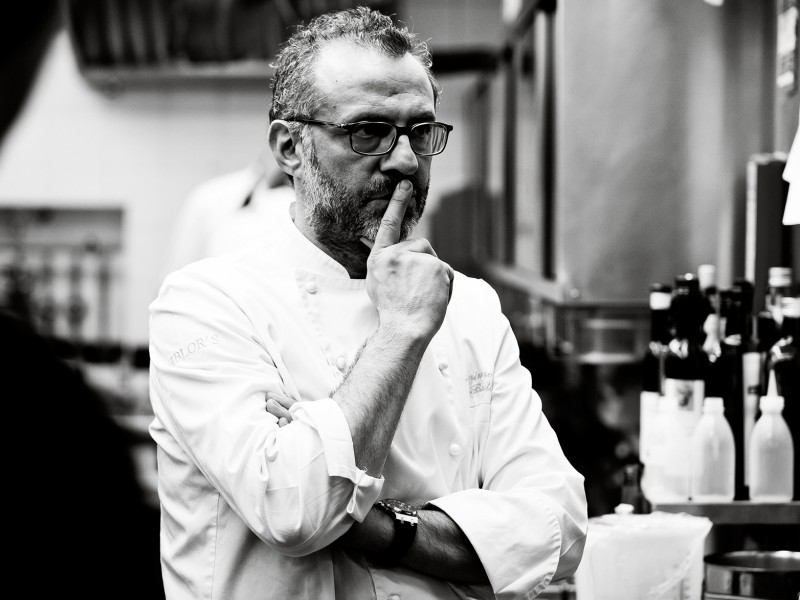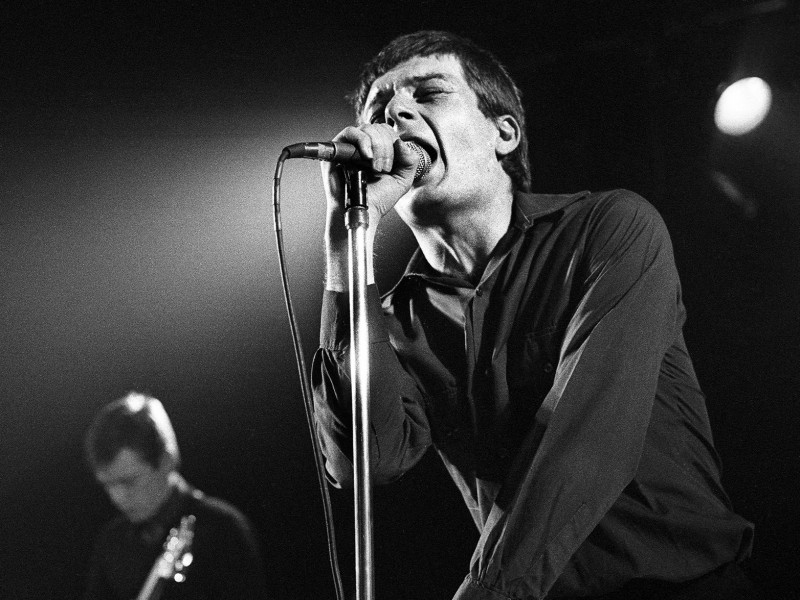“They were all impressed with your Halston dress,” sang Billy Joel in his hit song Big Shot (1979), Joel could not have picked a bigger name in American fashion at that time to attire his leading lady in. In the 1970s, Halston was the go to designer for the luminaries of New York society. Tall, handsome, charismatic, daring and impeccably dressed in his signature black turtleneck, Halston exuded style and elegance ahead of his time. The visionary instinctively knew how to dress a woman using a ‘less is more’ approach.
Born Roy Halston Frowick in Des Moines, Iowa, in 1932, Halston was the second of four children. From an early age Halston was creating hats for his first muse—his mother Hallie Mae. At high school, Halston became the wardrobe consultant to many of his family and friends. In 1952, Halston spent a spring semester at Indiana University, but left and enrolled in a fashion illustration course at the Chicago Art Institute. He balanced his evening classes with a window dressing job at the department store, Carson Pirie Scott and Company, which brought him into contact with the city’s social elite. These contacts turned into the first customers for the hats he was beginning to make. Halston’s creations caught the eye of Lilly Daché, the eminent New York milliner, who would eventually summon Halston to come and work for her. After a year with Daché, he left feeling he wasn’t receiving the recognition he deserved. Through connections he had made while working for Daché, Halston found himself at Bergdorf Goodman. He was given his own label, Halston of Bergdorf, and a budget that suited his expensive taste.
The rise of this all American style maven truly begins with another iconic figure, Jacqueline Kennedy. At the 1961 inauguration of her husband, Kennedy wore a beige felt pillbox hat, designed specifically for her by Halston. Diana Vreeland and Halston suggested a wardrobe for Kennedy to wear on the auspicious occasion, making a bold statement by presenting the First Lady in a cloth, rather than a fur coat. Though the pillbox is the most recognised of Halston’s hats, it was not the only one he made for Kennedy. Halston was her favourite milliner and he designed many hats for her during and after JFK’s political reign. His creations graced the covers of style bibles Vogue and Harper’s Bazaar, and provided the proverbial ‘cherry on top’ to any event or outfit. A Halston hat was obviously de rigueur and the list of names was exhaustive: the Queen of England, Mrs Guinness, the Duchess of Windsor, Diana Vreeland and Barbra Streisand to name only a few.
Remaining true to his ‘less is more’ aesthetic, Halston made chic, classic, comfortable pieces, including cashmere sweaters, caftans, shirtdresses, pants, blouses and evening dresses—all in his distinctive style. “So much of what made Halston a genius is unseen in terms of the actual clothing. He was a creator of new forms of dress” enthused Harold Koda in Ultrasuede: In Search of Halston. “The very simple shapes, a tank top, neckline or dolman sleeve, but where they’re different is the way the garment is constructed. Unlike a normal caftan which is cut on the grain, what he’s done is played with it, everything is on a bias, everything is on a 45 degree angle. It then cleaves to all of the highpoints of the body, the top of the hipline, the bust, the shoulder. It’s an incredibly flattering way to create volume. Constructing the way nobody had thought of constructing a dress before. If that was folded metal, it would be extraordinary sculpture. I really regret that he himself never talked about the making of things. He always talked about the women who were wearing it.”
Halston understood all aspects of his business, from the cut, fall and draping of fabric to the appeal of celebrity. In an interview in Ultrasuede, Halston mused that “You are as good as the people you dress. Elizabeth Taylor, Jackie Onassis, Bianca Jagger, Betty Ford, Candice Bergen … one time 58 of them showed up in the same dress … It was one of those dresses that worked for everybody.” Koda recalls in Ultrasuede that “He had the matrons and Marisa Berenson. The IT girl of the moment was wearing Halston at the same time as Katharine Graham. And it’s the same clothing! Who does that anymore?”
Hailed as the fashion show of the century, the 1973 Versailles extravaganza saw five French designers: Hubert de Givenchy, Yves Saint Laurent, Pierre Cardin, Emanuel Ungaro and Marc Bohan of Christian Dior—along with five American: Anne Klein, Stephen Burrows, Bill Blass, Oscar de la Renta and Halston—showcase their work at a fundraiser to save the famed Château de Versailles. The French designers presented a staid show, in complete contrast to the Americans, who presented a contemporary, fast paced show, full of colour, movement and personality, showcasing models of a range of ethnicities. The show was an unmitigated success. “Saint Laurent threw his book up into the air and said ‘we’ve learnt something tonight’,” recalls Liza Minnelli in Ultrasuede. This ‘win’ was a coup for American design, especially due to the dominance of the French fashion industry at the time.
A fortuitous relationship was struck between Halston and Andy Warhol in the early 1960s. In Ultrasuede, Glenn O’Brien recalls that there was a “Mutual fascination between Andy and Halston. At the beginning they were a little bit shy of one another, then they soon became thick as thieves.” They shared many common experiences over the course of their careers, and both worked with new materials and technologies. Warhol was a regular at Halston’s shows, and Halston collected Warhol’s work fervently and featured in several of Warhol’s artworks. They both had a natural affinity for publicity and understood the importance of the brand. They were equally at ease in all stratas of society, from their well to do clients to the hoi polloi. Warhol’s studio ‘The Factory’ was a melting pot of artists, models, musicians and others of the creative bent, while Halston similarly gathered all his ‘friends’, in a similar expression of the world he wanted to inhabit.
Halston’s cabine of models became known as the ‘Halstonettes’ and consisted of Elsa Peretti, Karen Bjornson, Pat Cleveland, Anjelica Huston, Marisa Berenson, to name only a few. Halston chose these young women not only for their height and beauty, but also their ethnic diversity. The Halstonettes were a reflection of Halston’s vision of youth, beauty, glamour, vibrancy and communicated a particular vision and lifestyle. Wherever Halston went, so did they.
The Halston House or ‘101’ era began in 1974. Designed by the renowned architect Paul Rudolph it had the distinction of being the only house built in Manhattan following World War II. Halston may have been the home’s second owner, but in many ways it was as if the house had always been intended for him. “It is here that I’ve discovered that modern is the only way to live. I like the simplification of living with only a few things,” said Halston.1 Halston’s minimalist aesthetic was on show as was his most extravagant selection of Warhol’s, Rigaud candles and the ever present orchids. The house was synonymous with parties, decadence and photo shoots. To be received at one of Halston’s legendary dinner parties, was to know you had made it. Regular guests included Bianca Jagger, Liza Minelli, Elizabeth Taylor and Truman Capote. Warhol polaroids still line the hallway at 101, documenting some of the company: Yves Saint Laurent, Betty Bacall, Salvador Dali, Betty Ford and Jackie Kennedy.
America in the 1970s—and in particular New York—was in a state of unrest. A high crime rate, easy access to drugs, prostitution, the Vietnam War, Richard Nixon and the Watergate affair, all led to a climate of cynicism amongst the populace. Amidst all this mayhem Studio 54 opened in 1977. A world where fashion, music and entertainment merged, where everything was fabulous and glamorous—a refuge from the chaos. For Halston and Warhol this was the time of “their delirious reign as the absolute monarchs of Manhattan nightlife,” according to Bob Colacello.2 In the beginning everyone would gather at 101 for a light dinner and refreshments, before heading to the club. The parties, the people, the stories! 101 was the hottest ticket in town, everyone could relax, free from the paparazzi’s gaze, though Warhol’s camera was notoriously ever present.
In 1978 the move to the 21st floor of newly built Olympic Tower was facilitated by Norton Simon, who thought Halston’s growing success required a far more suitable address. Halston turned the space into a workroom, private office, conference room and two fitting rooms for clients. All the rooms had floor to ceiling windows and similarly floor to ceiling mirrored doors. “It was like being in a glass box” reminisced Pat Cleveland in Ultrasuede. The mirrored doors could be opened up to create a space that seated 300 people—very handy for fashion shows and parties.
Halston had always had a desire to dress middle class America, and in an unprecendented move, Norton Simon negotiated a licensing deal with J.C. Penney that would see Halston design a womenswear line for the department store, with a men’s and children’s line to follow. This first collection was shown in Fall 1983. Unfortunately, the fashion world was not ready and Bergdorf Goodman dropped the Halston ready-to-wear line, while the Halston III line at J.C. Penney was discontinued due to poor sales. The J.C. Penney debacle was the beginning of the end for Halston. That same year Norton Simon was sold and Halston resented the interference from the new owners, subsequently fighting to retain control of his name and business. His final collection was shown in Spring 1984 and by the Summer, Halston had walked out of Olympic Tower.
On March 26, 1990, Halston died of Kaposi’s sarcoma, an AIDS-defining illness. His remains were cremated and scattered over the waters near Montauk, where he spent many idyllic summer weekends. A private funeral was held on March 31, and a tribute at Lincoln Center’s Alice Tully Hall was organised by Liza Minelli to honour her ‘daring and unstoppable’ best friend.
Halston’s influence and minimalist style can still be seen today. Names such as Ralph Rucci, Donna Karan, Narciso Rodriguez, Tom Ford, Thom Browne, Marc Jacobs, Diane von Fürstenberg, Calvin Klein and Naeem Khan, have been inspired by his aesthetic. Donna Karan’s Seven Easy Pieces; Diane von Fürstenberg’s Wrap Dress; Narciso Rodriguez’s minimalism; Calvin Klein’s colour palette, simplicity and wearability; all nod to the hailed designer. Tom Ford’s work at Gucci evokes the sexuality of Halston and similarly at YSL Ford “continued to display a louche attitude that recalled the best of Halston,” states Robin Givhan in The Battle of Versailles.
Halston’s legacy is both enduring and relevant today. Perhaps it is Koda that best summed up Halston’s appeal and influence when he wrote: “There are people who create fashions using techniques and forms that are pre-existing but modifying them, ornamenting them, and changing proportions and silhouettes so it is of their time. But in rare instances there are designers who extend the vocabulary of techniques to something that forms a new language, and Halston is one of them.”3
Footnotes:
1. Lesley Frowick, Halston: Inventing American Fashion, Rizzoli International Publications, 2014, p.101.
2. Ibid. p.147
3. Ibid. p.48
Related Features
-
213
-
-
-

